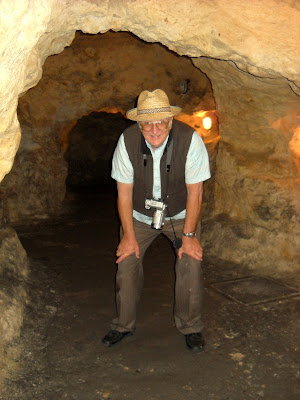We paid our money and descended a long set of stairs into the caves beneath the city. We could see places where the ceiling had been broken through and repaired, probably from a construction excavation. This cave is a wet cave but lacks the mineral content needed for the formation of stalagmites and stalactites. Thus it is a durable cave. No need for tour guides and barriers. So you are free to explore everywhere and at your own pace.
But here is the cool part. With the aquifer, it is an underground lake. We came to the shore of the lake where you could borrow a little tin boat big enough for two people and a paddle. The passages were too narrow to use two paddles and some places one paddle was one too many, and yes the ceilings became very low. A hard hat would have been very useful. The sounds of these little tin boats bouncing off the side walls was about all you could hear. All in all it was great fun.
It was quite unbelievable how clear the water was and it is apparently quite therapeutic. The local hospital has access to the lake in their basement and patients can bathe at their leisure.
You have likely read about Hungary's Toxic Red Sludge disaster. That took place just 20km north of this spot. Fortunately Tapolca is at a slightly higher elevation and will likely be spared any of that devastating contamination.
Heather: The whole country of Hungary has been blessed with hot water springs that have health benefits for various neurological and muscular problems. Many of them were found in the early part of the 20th century while drilling for oil. Very few explorations found oil but brought thermal water gushing to the surface. Ever resourceful, the Hungarians turned from oil production to building spas for bathing in the health restoring waters. Although many spas are not that old some of the baths date back to the 1500's. The Imperial Baths in Budapest were established by the Turks between 1566 and 1570 and the have been used ever since. The hot water for these baths is piped from springs near by. Here in Pécs we walk by the remains of the 16th century Turkish baths every day. We have yet to try any of the world famous baths -- but on days when my muscles hurt I am sorely tempted!





So cool!
ReplyDelete